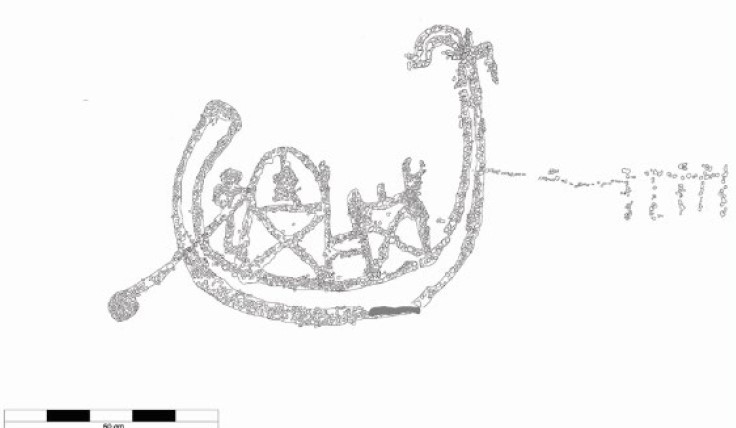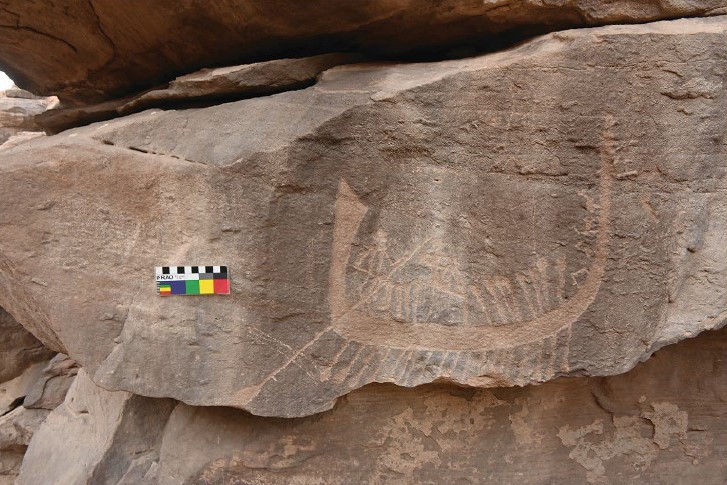A newly-discovered rock art panel on the western bank of the River Nile may depict an Ancient Egyptian authority figure from the dawn of the First Dynasty. Based on the style and content of the engraving, the author of a new study suggests that it was most likely commissioned by an early political ruler during the Protodynastic period, which predated the creation of the Egyptian state and the establishment of the first pharaoh.
Found behind a pile of rubble at Gebel Qurna – which sits around 10 kilometers (6.2 miles) north of Aswan – the ancient artwork depicts an ornate boat with a sickle-shaped hull, which appears to be dragged against the current by five figures while a standing oarsman helps to propel the vessel. Onboard, a seated figure can be seen inside a raised palanquin.
“The shape engraved inside the shelter is interpreted as a seated human figure, of which only the head and right shoulder are visible, along with a chin elongation typical for depictions of early rulers that might designate the false beard worn by kings since the First Dynasty,” writes Dr Dorian Vanhulle, author of a new study about the ancient artwork. “The vertical stroke on the head of the seated figure cannot be easily explained, although it might be a headdress of some sort,” he adds.

The figure in the central palanquin may have belonged to a Protodynastic ruling family.
Image credit: Dorian Vanhulle, AKAP
Rock art of this sort is extremely uncommon in Egypt, although Vanhulle was able to determine its approximate age by comparing it with designs found on other artifacts. For instance, he explains that the engraving closely resembles an illustration found on a mace-head depicting a seated figure being presented to Narmer, Egypt’s first Pharaoh, who ruled from around 3100 BCE.
“In light of these observations, it seems reasonable to suggest that the panel… was produced at the dawn of the First Dynasty, perhaps shortly before the reign of Narmer,” writes Vanhulle. This conclusion is supported by the style of the boat, which “belongs to a type typical of the transition from the Protodynastic to the Early Dynastic periods.”
“The vertical extremities, along with the ‘knife-shaped’ profile of the stern, are good chronological markers,” explains the study author. The boat also matches with that seen on another example of Protodynastic rock art at Wadi Abu Subeira.
“Boats are among the most frequently recurring motifs in Egyptian iconography”, writes Vanhulle. “During the Predynastic and Protodynastic periods (c. 4500-3085 BCE), the periods which foreshadowed Pharaonic Egypt, the boat is ubiquitous and invested with complex ideological and symbolic meanings,” he said in a statement sent to IFLScience.

The boat matches this engraving from Wadi Abu Subeira.
Image credit: Dorian Vanhulle, AKAP
It’s currently unclear who the figure in the palanquin is supposed to represent, although Vanhulle says that the individual may have been a member of a ruling family from the Protodynastic period, when the so-called Naqada culture of northern Egypt began extending its influence southwards, resulting in the establishment of the Egyptian state in the latter part of the fourth millennium BCE. “All this suggests that the panel is a production commissioned by an early form of politico-religious power at the onset of the First Dynasty,” he writes.
Unfortunately, the artwork lacks a serekh – a type of inscription found on rock art from the First and Second Dynasties – which means the exact purpose of the engraving remains open to speculation. Nonetheless, the discovery adds to our understanding of the processes that led to the formation of the Egyptian state, indicating that authorities may have commissioned rock art to mark their territory and assert their dominance.
The study has been published in the journal Antiquity.
Source Link: 5,000-Year-Old Rock Art May Show One Of Ancient Egypt’s First Rulers